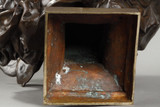A bronze bust with a medal patina depicting a handsome young man with a gentle gaze and butterfly wings. He is draped in a garment held by a knot at his chest. His bodice is decorated with a rose. A butterfly rests in his curly hair. This could be Zephyr, the personification of the wind who, in the myth of Cupid and Psyche, is tasked with carrying the young woman to Eros's palace; Psyche herself is represented in the form of a butterfly. It could also be the artist's interpretation of Psyche (a very feminine face but without breasts).
In Greek, the first meaning of the noun (psuchè) is "breath," from the verb (psuchô), "to breathe upon." It designates the breath of life, hence the soul, as opposed to the body. It also means butterfly. Psyche is the personification of the human soul. Psyche being a very beautiful woman, Aphrodite is jealous of her and asks her son Eros (Love or Cupid) to make her fall in love with a repulsive man. Instead, he falls in love with her and asks Zephyr to carry her away, even though her father has abandoned her on a steep rock following the oracle of Delphi. Eros reaches her at night and begs her not to try to discover his identity. Urged on by her sisters and doubting this beloved, she takes advantage of her lover's sleep to light an oil lamp and accidentally burns him. Betrayed, he flees, and she falls mad with grief and remorse. Aphrodite (Venus), upon learning of her son's affair with Psyche, imprisons him in her palace and subjects the young lover to harsh trials, which she eventually overcomes with the help of the gods (Zeus or Pan). However, during the final trial—to retrieve a fragment of Persephone's beauty—Persephone's curiosity once again leads to her downfall, and she falls into a deep sleep. Meanwhile, Eros, whose wound has healed, escapes from Aphrodite's palace and finds his beloved, whom he revives with his arrow. Moved by this story, Zeus permits their union and marriage on Mount Olympus. Thanks to ambrosia, Psyche becomes immortal and is granted butterfly wings. The story of Cupid and Psyche was particularly popular in the 19th century.
Circa: 1890
Condition report: In good overall condition. Signs of wear consistent with age.
Base size: 14cm x 14cm
Delivery
Europe: €100
US/Canada/HK: €200
Rest of the world: Price upon request
- Reference :
- 3177
- Width :
- 33 (cm)
- Height :
- 55 (cm)
- Depth :
- 28 (cm)
- Era:
- 19th century
- Style:
- Art Nouveau
- Materials:
- Bronze









































